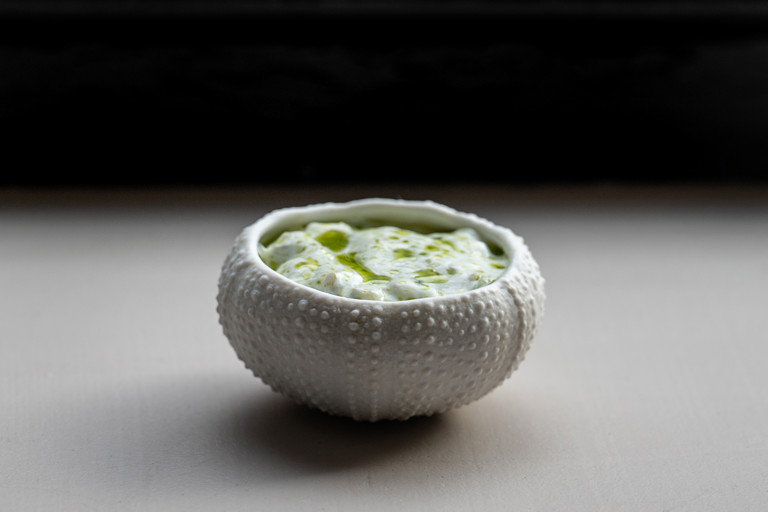Langoustine custard, crab, dill
This elegant seafood starter from Joe Laker consists of a base of langoustine custard, topped with pickled shallots, white crab and buttermilk split with a homemade dill oil. The langoustine stock is reduced down to an intensely flavourful liquid, which forms the base of the custard.
Ingredients
Metric
Imperial
Dill oil
- 150g of dill, leaves picked
- 150g of vegetable oil
Langoustine stock
- 2 bulbs of fennel, roughly chopped
- 6 tomatoes, roughly chopped
- 4 sticks of celery, roughly chopped
- 2 carrots, peeled and roughly chopped
- 1 leek, roughly chopped
- 500g of tomato paste
- 10g of fennel seeds
- 750g of white wine
- 5kg langoustine shells
- fish stock, to cover
- olive oil, for cooking
Langoustine custard
- 6 eggs
- 40g of cream
Garnish
- 3 shallots, diced
- vinegar, such as white wine vinegar or apple cider vinegar
- 120g of white crab meat, cooked
- 300ml of buttermilk
Equipment
- Thermomix
- 8 ramekins
Method
Begin by making the dill oil. Blend the dill with the oil in a Thermomix at 100°C for 5–7 minutes. Alternatively, first blanch the dill for 5 seconds and then blend in a regular blender with the oil until completely broken down, and the oil is bright green
- 150g of dill, leaves picked
- 150g of vegetable oil
Pass the oil through a fine mesh strainer or some muslin cloth, and then transfer to a container and freeze until solid. Once frozen, the water will turn to ice and sink to the bottom. The oil should stay soft and can be scraped off and set aside
Cover the diced shallot for the garnish with enough vinegar to cover and set aside
- 3 shallots, diced
- vinegar, such as white wine vinegar or apple cider vinegar
Heat up plenty of oil in a large pan, and once hot add the vegetables for the langoustine stock. Cook the vegetables until browned – about 15 minutes – and then add the tomato paste and cook out for another 8–10 minutes
- 2 bulbs of fennel, roughly chopped
- 6 tomatoes, roughly chopped
- 4 sticks of celery, roughly chopped
- 2 carrots, peeled and roughly chopped
- 1 leek, roughly chopped
Add the fennel seeds and lightly toast them
- 10g of fennel seeds
Add the white wine and reduce down by half
- 750g of white wine
Add the langoustine shells and a good pinch of salt, and brown them all over
Add enough fish stock to cover, and then bring to the boil. Simmer for 2 hours
- fish stock, to cover
Once the stock has simmered, strain out the solids and then return to a pan. Reduce the stock to 500ml. This will take a long time, and the best way to speed it up is to use a pan with a large surface area like a deep frying pan or wok
Next make the custard. Whisk together the eggs with 200ml reduced langoustine stock and the cream. Pass the stock through a fine mesh strainer, and divide into 8 ramekins
- 6 eggs
- 40g of cream
Steam the ramekins in a bamboo steamer with the water at a bare simmer for 10 minutes, or else steam in a steam oven set to 80°C for 5 minutes. They should be set but still have a good wobble
To serve, divide the crab meat over the top of of each custard, and then add some pickled shallot over the crab. Split some buttermilk with a splash of dill oil, then spoon over the top, making sure you can still see the streaks of dill oil
- 120g of white crab meat, cooked
- 300ml of buttermilk
Get in touch
Please sign in or register to send a comment to Great British Chefs.


